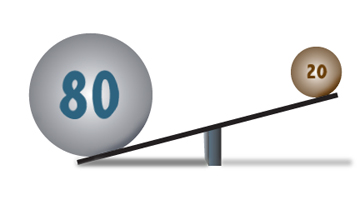 You may have heard of the Pareto principle. It is named
after Vilfredo Pareto, an Italian economist, who discovered something about the
world around him: there was an 80/20 imbalance of inputs and outputs at work in
just about every aspect of society. He first realized this when he discovered
that 80 percent of the land in Italy was owned by 20 percent of the people. He
then recognized that this radical imbalance applied to other areas of life too.
For instance, in business, the 80/20 rule was found to be at work in these
areas:
You may have heard of the Pareto principle. It is named
after Vilfredo Pareto, an Italian economist, who discovered something about the
world around him: there was an 80/20 imbalance of inputs and outputs at work in
just about every aspect of society. He first realized this when he discovered
that 80 percent of the land in Italy was owned by 20 percent of the people. He
then recognized that this radical imbalance applied to other areas of life too.
For instance, in business, the 80/20 rule was found to be at work in these
areas:
- 80 percent of the sales was produced by 20
percent of sales force
- 80 percent of business revenue was produced by
20 percent of its customers
- 80 percent of the customer service complaints
came from 20 percent of the customers.
The Pareto principle – or the Law of the Vital Few, as it
has been called - has been used by business bloggers, coaches and seminar
speakers to spur businesses to focus on the 20 percent and ignore the 80. This has spilled over to marketing, where the
imbalance between what you do to get someone’s attention and what you do to
entice them to buy is often targeted by the disciples of the 80/20 rule. They
would jettison the 80 percent of marketing that is warming a prospect up to
your brand and jump right to the 20 percent that has to do with the sale. That
may work if you are selling commodities where only the price really matters.
However, if you are selling a product or a service that takes a bit more time
to walk a customer through the sales process, there may be value in the 80 that
is often unappreciated. It is like demanding that a mixture of eggs, flour,
baking soda and sugar turn into a cake without baking it. There is marketing
value in the 80 percent if you are marketing correctly.
The Pareto principle is the universal truth about the
imbalance of inputs and outputs. But in
marketing, can the 80 really be listed as an imbalance or is it the
counterbalance of the 20? Let me explain. I like to break marketing into three
phases: awareness, first time sales and retention marketing. One step leads to
the other. It is impossible to get to first time sales without making potential
customers aware of your brand, and likewise, it is impossible to retain great
customers if you never sell them in the first place. Awareness marketing is the
80 percent. It defines your brand and
pushes it into the marketplace so people understand it. It does not sell your brand. That is the next phase
of marketing – first time sales. On the other extreme, retention marketing is
dealing with the 20 percent – people who have become your customers, but need a
reason to buy from you again. Retention marketing is all about creating a relationship between the brand
and the customer. We want them to be customers for life and to recommend
your brand to others. Here is the truth: you cannot get to the 20 percent of
customers who are sold on your brand if you don’t go through the 80 percent who
have to become aware of your brand in the first place.
But what about the 80 percent who never become the loyal
customer? Why waste time with the 80 if they never get to where you want them
to be? Here again, it is important to understand the way brands interact in the
marketplace. There are brands I know about and think highly of, but would not
buy. Why? I am not a buyer of what they sell…I am not really their target
market. But I know people who are in their target market. In fact, my opinion
of the brand – be it favorable or unfavorable – might influence someone else to
buy or not buy from them. For instance, I had a friend who was doing some home
improvement. They asked if I knew anyone I could recommend to do their work. I
did. I do not need the same kind of work done on my house, so I am not a
customer, but I know the good reputation of the company I recommended. Within
the 80 percent are powerful influencers and you should not ignore them with
your marketing efforts.
Is there a scenario when 80 percent of your marketing is
ineffective? Yes, and here is how you know it is failing: when you are not
moving anyone through the three phases. In other words, if all you do is put
out content marketing, but never transition a prospect to make an appeal to
buy, you are failing with the 80 percent. Throw that solution away and try
another. When 80 percent is the counterbalance
to the 20, you are moving prospects from one phase to the other. When it is
not, it is the imbalance to the 20.
Vilfredo Pareto made a key discovery about the imbalance of
life, but sometimes what seems to be an imbalance could work to your benefit. Be
smart about your marketing: use the 80 to counterbalance the 20.